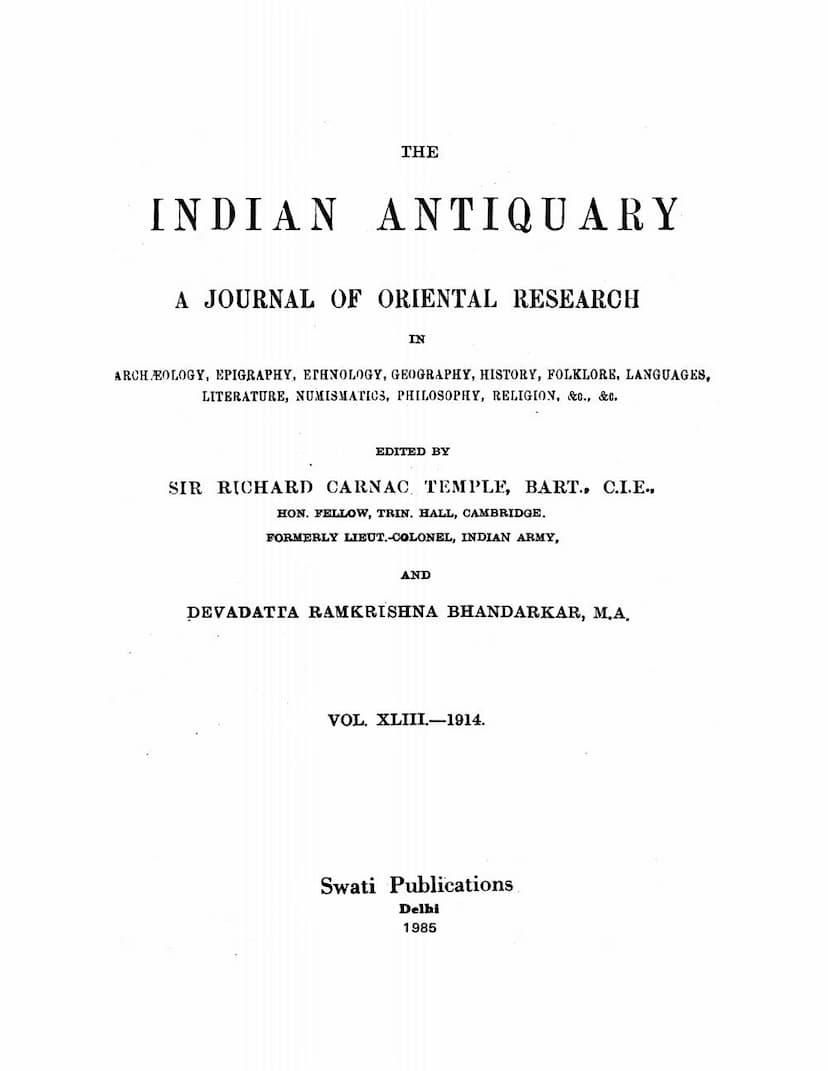Indian Antiquary Vol 43
Added to library: September 1, 2025

Summary
The provided text is a volume from the Indian Antiquary, a journal of Oriental research, specifically Volume XLIII from 1914. Edited by Sir Richard Carnac Temple and Devadatta Ramkrishna Bhandarkar, and published by Swati Publications, this volume contains a diverse collection of articles on various aspects of Indian history, culture, and languages.
Here's a summary of the key themes and articles relevant to Jainism and broader Indian history presented in the provided pages:
Key Themes and Content:
- Indian History and Dynasties: A significant portion of the volume, particularly the article "THE HISTORY OF THE NAIK KINGDOM OF MADURA" by V. Rangachari, delves into the political history of South India, tracing the Pandyans, the Muhammadan conquest, the rise of the Vijayanagar Empire, and the subsequent establishment and rule of the Naik dynasty in Madura. It discusses provincial organization, the roles of various viceroys, and the impact of Vijayanagar supremacy on the region.
- Jainism: While not exclusively a Jain text, the volume contains discussions relevant to Jainism. Specifically, the article "THE DATE OF MAHAVIRA" by Jarl Charpentier attempts to ascertain the historical date of Mahavira, the central figure of Jainism. It analyzes various traditions and evidence from Brahmanical, Buddhist, and Jain scriptures, as well as inscriptions, to discuss the chronological placement of Mahavira and his relationship with Buddha. This article critically examines the traditional date of Mahavira's death (527 BC) and proposes an alternative date of 467 BC, aligning with the contemporary understanding of Buddha's life.
- Linguistics and Philology: Several articles focus on language and grammar. "NOTES ON THE GRAMMAR OF THE OLD WESTERN RAJASTHANI WITH SPECIAL REFERENCE TO APABHRAMÇA AND TO GUJARATI AND MARWARI" by Dr. L. P. Tessitori provides a detailed linguistic analysis of Old Western Rajasthani, its origins from Apabhramça, and its relation to modern Gujarati and Marwari. "THE PAHARI LANGUAGE" by Sir George A. Grierson discusses the classification and distribution of Indo-Aryan languages spoken in the sub-Himalayan hills, tracing their historical connections to tribes like the Khasas and Gurjaras.
- Religious History and Practices: The volume touches upon various religious aspects, including:
- "DHARANI", OR INDIAN BUDDHIST PROTECTIVE SPELLS" by L. A. Waddell translates Tibetan Buddhist protective spells, offering insights into early Indian Buddhist practices, the deification of certain figures like Garuda and Tara, and potential pre-Buddhist and pre-Vedic elements in these spells.
- The articles on the history of the Madhva Acharyas by G. Venkoba Rao and the history of the Naik Kingdom discuss the religious landscape, the rise of popular movements within Vaishnavism (Tengalaism) and Saivism (Salva-Siddhantism), and the patronage of temples and religious endowments by the Vijayanagar rulers and the Naiks.
- Epigraphy and Archaeology: The article "A NEWLY DISCOVERED COPPER PLATE GRANT OF BHASKARAVARMAN OF KAMARUPA" by Padmanath Bhattacharya discusses an important epigraphical find, shedding light on the ancestry of King Bhaskaravarman and historical aspects of Assam. The "HATHAL PLATES OF (PARAMARA) DHARAVARSHA" by Pandit Vishweshwar Nath Shastri presents a copper plate grant from the Paramara dynasty.
- Early European Accounts and Trade: The article "DOCUMENTS RELATING TO THE FIRST ENGLISH COMMERCIAL MISSION TO PATNA, 1620-1621" edited by Sir R. C. Temple, provides valuable primary source material detailing the early interactions of the English East India Company with the region, including trade commodities, local interactions, and administrative challenges.
- Philology and Etymology: Articles like "MISCELLANEA. COBRA MANILLA" by H. Hosten and "MISCELLANEA. SHANDY" AND "SHINDY" by E. Hultzsch explore the etymology and usage of specific words, highlighting the intersection of languages and cultural influences.
- Book Reviews: Several "BOOK NOTICES" and "BOOK-REVIEW" sections offer critical evaluations of contemporary scholarly works on topics such as "The Gardens of the Great Mughals," "The Mudrarakshasa," and "The Bower Manuscript."
In essence, Volume XLIII of the Indian Antiquary serves as a rich repository of scholarly articles covering a broad spectrum of Indian studies, with specific, significant contributions to understanding Jain chronology, the history of South India, linguistic evolution, and early Buddhist practices, alongside fascinating glimpses into historical records of trade and cultural encounters.